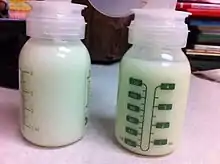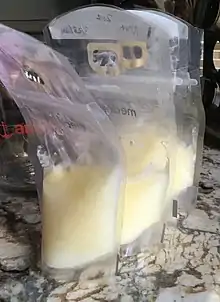Human milk bank
A human milk bank or breast milk bank is a service which collects, screens, processes, and dispenses by prescription human milk donated by nursing mothers who are not biologically related to the recipient infant. The optimum nutrition for newborn infants is breastfeeding, if possible, for the first year.[1] Human milk banks offer a solution to the mothers that cannot supply their own breast milk to their child, for reasons such as a baby being at risk of getting diseases and infections from a mother with certain diseases,[2] or when a child is hospitalized at birth due to very low birth weight (and thus at risk for conditions such as necrotizing enterocolitis), and the mother cannot provide her own milk during the extended stay for reasons such as living far from the hospital.[3]


Human milk banks had an increase in the amount of milk collected in 2012 compared to 2007, in addition the amount of milk donated by each donor had also increased.[4] Mothers' Milk Bank (MMB) says, this service provides mothers with an alternative to infant formula and allows the mother to give their newborn the nutrition it needs for healthy growth.[5] The International Milk Banking Initiative (IMBI), was founded at the International HMBANA Congress in 2005. It lists 33 countries with milk bank programs.[6] The World Health Organization (WHO) states that the first alternative to a biological mother not being able to breast feed is the use of human milk from other sources.[7]
The primary and by far the largest group of consumers of human breast milk are premature babies. Infants with gastrointestinal disorders or metabolic disorders may also consume this form of milk as well. Human breast milk acts as a substitute, instead of formula, when a mother cannot provide her own milk. Human breast milk can also be fed to toddlers and children with medical conditions that include but are not limited to chemotherapy for cancer and growth failure while on formula.
History
Donating breast milk can be traced back to the practice of wet nursing.[8] The first record of regulations regarding the sharing of breastmilk are found in the Babylonian Code of Hammurabi (1800 BCE).[8] These regulations were motivated by the long-held belief that infants inherit the nurse's traits through their breast milk.[8] By the 11th century European culture considered breastfeeding indecent, which led wet nursing to become common practice among royalty and aristocracy of Europe.[8] The practice of wet nursing declined by the 19th century due to concerns regarding unhealthy lifestyles among nurses.[8] Consequently, the medical community began researching the effects of alternative nutrition on neonates. Theodor Escherich of the University of Vienna conducted studies from 1902 to 1911 investigating different sources of nutrition and their effect on neonates. His studies demonstrated that breastfed neonate's intestinal bacteria was significantly different compared to neonates fed by other means.[8] In 1909, Escherich opened the first human milk bank.[9] The following year, another milk bank opened in the Boston Floating Hospital, the first milk bank in the United States.[10]
The 1960s saw a decline in milk banking because of recent advances in neonatal care and baby formula.[10] Despite these new advancements, in 1980 the World Health Organization and the United Nations Children's Fund maintained their position that donor breast milk is the best alternative to the mother's breast milk.[8] The practice of milk banking declined further with the HIV epidemic. The need for stringent screening increased the cost of operating milk banks, forcing them to close doors.[10]
Today, however, improved screening methods and standardization of procedure have made donated milk a viable alternative to mother's breast milk. The ability to pasteurize and store breast milk for up to 8 months[11] means milk banking could become a global enterprise.
Donor Requirement
A donor must:
- Be healthy
- Be in the process of lactation
- Undertake a chest x-ray or tine test
- Have a negative VDRL
- Have no evidence of hepatitis
- Be HIV negative
More requirements may apply. For example, the requirements in Australia can be found at: http://jhl.sagepub.com/content/2/1/20.full.pdf
Concerns
Some concerns that surround human milk bank include:
- Cost
- Availability
- Lack of health care provider interest
- Concern about the type of women who might donate [12]
Consumers
After the milk has been donated the primary consumer of the milk are premature babies; other consumers include adults with medical complications or conditions. The main reason why premature babies consume donor milk is that the mother cannot provide milk for the baby. The donor milk therefore acts as a substitute.[13]
Health benefits of human milk banks
Human milk banks offer families a chance to provide their child with reliable and healthy milk from other mothers. Human milk banks are needed as they offer milk which mostly is consumed by children whose mothers are not able to provide them with reliable milk.[14]
Human Milk Banks Around the World
Brazil and Latin America
Brazil has an extensive network of 217 milk banks, and is considered to have the most cost efficient system of milk banking in the world.[15] Since the inception of the first milk bank in 1985, the infant mortality rate in Brazil has dropped 73% due, in part, to the popularization of milk banks. In 2011, 165,000 liters (5,580,000 fl oz) of breast milk were donated by some 166,000 mothers, and provided to nearly 170,000 babies. The Brazilian and Ibero-American Network of Human Milk Banks coordinates these efforts. All donors are screened: in general, they must be healthy and not be taking any medication. The Brazilian system is defined by its inexpensive pasteurization of milk and has spread to other countries such as Spain, Portugal, the Cape Verde Islands, and portions of the rest of Latin America.
Europe
There are 223 active human milk banks in 28 countries within Europe, with 14 more planned as of November 2018. Currently, Italy has the most milk banks, at 37, while Turkey has the least, having no milk banks.[16]
North America
The Human Milk Banking Association of North America (HMBANA) has a "Guidelines for the Establishment and Operation of a Donor Human Milk Bank" [17] that establishes exhaustive guidelines for safe milk collection and usage in North America. There are 16 milk banks in North America as of 2014. They collect about 3,000,000 oz per year as of 2013.
South Africa
South Africa has a breast milk collection and distribution program, Milk Matters, based in Cape Town.[18]
Singapore
Singapore launched a three-year pilot donor breast milk bank on Thursday 17 August 2017. It is a collaboration between KK Women's and Children's Hospital (KKH) and Temasek Foundation Cares. The foundation has set aside S$1.37 million (US$1 million) for the milk bank, which will collect, screen, process and store breast milk from donor mothers.[19]
Australia
As of 2014 Australia has a total of 5 Human Milk Banks in operation:
- PREM bank (based at King Edward Memorial Hospital, WA and also supplying Princess Margaret Hospital);
- Royal Prince Alfred (RPA) Hospital neonatal intensive care unit (NSW);
- Mothers Milk Bank Pty Ltd (a private charity, previously located on the Gold Coast, now at Tweed Heads NSW and supplying the Brisbane Mater Children's Hospital as well as some babies in the community);
- Mercy Health Breastmilk Bank (commenced 2011 at Mercy Hospital for Women, Heidelberg VIC); and
- Royal Brisbane and Women's Hospital (RBWH) Milk bank (commenced November 2012 at the RBWH Grantley Stable Neonatal Unit).[20]
- Mother's milk bank.[5]
India
- Asia's first milk bank was established in 1989 at Sion Hospital, Mumbai, India under the leadership of Dr Armida Fernandez, and is presently run by Dr Jayashree Mondkar, a neo-natologist.[21]
- In 2017, the first milk bank, called the Vatsalya — Maatri Amrit Kosh, was established at Lady Hardinge Medical College. It was established in collaboration with the Norwegian government and the Oslo University as part of the Norway–India Partnership Initiative (NIPI).[22]
- In September 2013, "Yashoda" Human Milk Bank was established in Dr. D. Y. Patil Medical College, Hospital and Research Centre, Pimpri, Pune in Maharashtra. Established with the partnership of Rotary Club of Nariman Point, Mumbai, it is the first human milk bank established in a private medical college in India. An advanced human milk bank and Comprehensive Lactation Management, Training and Research Centre (CLMTRC) were established on 31 January 2019.
See also
Footnotes
- Bertino, Enrico; Giuliani, Francesca; Occhi, Luciana; Coscia, Alessandra; Tonetto, Paola; Marchino, Federica; Fabris, Claudio (October 2009). "Benefits of donor human milk for preterm infants: Current evidence". Early Human Development. 85 (10): S9–S10. doi:10.1016/j.earlhumdev.2009.08.010. PMID 19800748.
- When Not to Breastfeed: Safety Issues for You and Baby
- "WHO | Feeding of low-birth-weight infants in low- and middle-income countries". WHO. Retrieved 2019-04-25.
- De Nisi, Giuseppe; Moro, Guido E.; Arslanoglu, Sertac; Ambruzzi, Amalia M.; Biasini, Augusto; Profeti, Claudio; Tonetto, Paola; Bertino, Enrico (2015-05-01). "Survey of Italian Human Milk Banks". Journal of Human Lactation. 31 (2): 294–300. doi:10.1177/0890334415573502. ISSN 0890-3344. PMID 25722356.
- "Mothers Milk Bank Charity | Australia | Breast Milk". mothersmilkbank. Retrieved 2019-04-25.
- "IMBI". www.internationalmilkbanking.org. Retrieved 2019-04-25.
- Carr, Tim. "Milk Banks | Amazing Breast Milk". Retrieved 2019-04-25.
- Moro, Guido E. (April 2018). "History of Milk Banking: From Origin to Present Time". Breastfeeding Medicine. 13 (S1): S–16–S–17. doi:10.1089/bfm.2018.29077.gem. ISSN 1556-8253. PMID 29624424.
- Jones, Frances (August 2003). "History of North American Donor Milk Banking: One Hundred Years of Progress". Journal of Human Lactation. 19 (3): 313–318. doi:10.1177/0890334403255857. ISSN 0890-3344. PMID 12931784.
- Haiden, Nadja; Ziegler, Ekhard E. (2016). "Human Milk Banking". Annals of Nutrition and Metabolism. 69 (2): 8–15. doi:10.1159/000452821. ISSN 0250-6807. PMID 28103607.
- de Waard, Marita; Mank, Elise; van Dijk, Karin; Schoonderwoerd, Anne; van Goudoever, Johannes B. (March 2018). "Holder-Pasteurized Human Donor Milk: How Long Can It Be Preserved?". Journal of Pediatric Gastroenterology and Nutrition. 66 (3): 479–483. doi:10.1097/MPG.0000000000001782. ISSN 1536-4801. PMID 29019853.
- Jones F (2003). "History of North American Donor Milk Banking: One Hundred Years of Progress". Journal of Human Lactation. 19 (3): 313–318. doi:10.1177/0890334403255857. PMID 12931784.
- Heiman, H., Schanler, R.J. (2006). Benefits of maternal and donor human milk for premature infants. Early human development 82, 781-787. Retrieved from http://ac.els-cdn.com/S0378378206002325/1-s2.0-S0378378206002325-main.pdf?_tid=7a9a5b2a-e4c2-11e4-8dcd-00000aacb35d&acdnat=1429248646_57f08db067cf2a164ce0db1708cf6aa3
- Simmer K., Hartmann B. (2009). "The knowns and unknowns of human milk banking" (PDF). Early Human Development. 85: 701–704. doi:10.1016/j.earlhumdev.2009.08.054.
- "Banking on 'liquid gold': How breast milk banks are saving infant lives |". Citizen Matters. 2018-09-21. Retrieved 2018-11-05.
- "EMBA". europeanmilkbanking.com. Retrieved 2018-11-05.
- "Human Milk Banking". www.breastfeedingindia.com. Retrieved 2019-04-25.
- Milk Matters
- "Singapore launches first donor breast milk bank". CNA. Retrieved 2019-04-25.
- Donor Human Milk Banking in Australia
- Lokmanya Tilak Municipal General Hospital and Lokmanya Tilak Municipal Medical College, Sion, Mumbai
- Health Secretary inaugurates ‘Vatsalya – Maatri Amrit Kosh’, a National Human Milk Bank and Lactation Counselling Centre
Further reading
- Kara W. Swanson, Banking on the Body: The Market in Blood, Milk, and Sperm in Modern America. Cambridge, MA: Harvard University Press, 2014.
Reference List
- Italian Association of Donor Human Milk Banks (2015) Survey of Italian Human Milk Banks. Retrieved from http://jhl.sagepub.com
- Bertino E., Giuliani F., Occhi L., Coscia A., Tonetto P., Marchino F., Fabris C. (2009). "Benefits of Donor Human Milk for Preterm Infants: Current Evidence". Early Human Development. 85 (10): 9–10. doi:10.1016/j.earlhumdev.2009.08.010. PMID 19800748.CS1 maint: multiple names: authors list (link)
- Nash, C., & Amir, L., (n.d.) Human Milk Banking: A Review. Retrieved from http://www.breastfeedingindia.com/breastfeeding/human_milk_banks.html
- Nagin, M. K., (2014). Human Milk Banks. Retrieved from http://breastfeeding.about.com/od/breastmilkpumpingcare/a/milkbank.htm
- Milk Banks. (n.d.). Retrieved from http://www.amazingbreastmilk.nhs.uk/support/milk-banks/